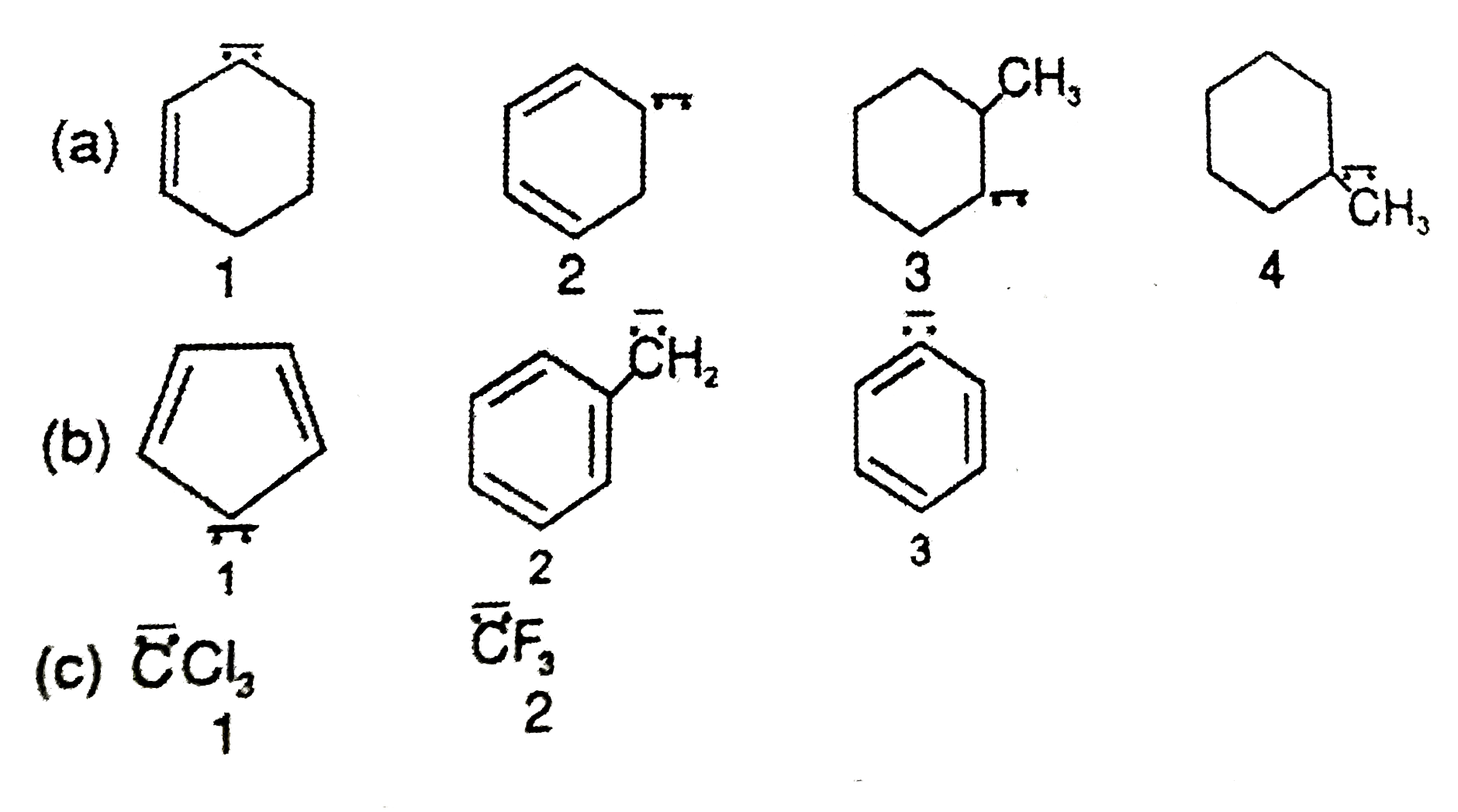Arrange the following in decreasing order of dipole moment
(1) m-Dichlorobenzene
(2) o-Dichlorobenzene (3) p-Dichlorobenzene
To arrange m-Dichlorobenzene, o-Dichlorobenzene, and p-Dichlorobenzene in decreasing order of dipole moment, we can follow these steps:
Step 1: Understand the Structure of Each Compound
- o-Dichlorobenzene (ortho): The two chlorine atoms are adjacent to each other on the benzene ring.
- m-Dichlorobenzene (meta): The two chlorine atoms are separated by one carbon atom on the benzene ring.
- p-Dichlorobenzene (para): The two chlorine atoms are opposite each other on the benzene ring.
Step 2: Analyze the Dipole Moments
The dipole moment depends on both the magnitude of the individual dipoles and the angle between them. The larger the angle between the dipoles, the smaller the resultant dipole moment.
- o-Dichlorobenzene: The angle between the dipoles is 60 degrees. This results in a higher dipole moment because the dipoles are more aligned.
- m-Dichlorobenzene: The angle between the dipoles is 120 degrees. This results in a moderate dipole moment as the dipoles are partially canceling each other out.
- p-Dichlorobenzene: The angle between the dipoles is 180 degrees. The dipoles are directly opposite each other, leading to cancellation of the dipole moments, resulting in the lowest dipole moment.
Step 3: Arrange in Decreasing Order
Based on the analysis of the angles and the resultant dipole moments, we can arrange the compounds in decreasing order of dipole moment:
1. o-Dichlorobenzene (highest dipole moment)
2. m-Dichlorobenzene (moderate dipole moment)
3. p-Dichlorobenzene (lowest dipole moment)
Final Answer
The decreasing order of dipole moment is:
o-Dichlorobenzene > m-Dichlorobenzene > p-Dichlorobenzene
---
- o-Dichlorobenzene (ortho): The two chlorine atoms are adjacent to each other on the benzene ring.
- m-Dichlorobenzene (meta): The two chlorine atoms are separated by one carbon atom on the benzene ring.
- p-Dichlorobenzene (para): The two chlorine atoms are opposite each other on the benzene ring.
The dipole moment depends on both the magnitude of the individual dipoles and the angle between them. The larger the angle between the dipoles, the smaller the resultant dipole moment.
- m-Dichlorobenzene: The angle between the dipoles is 120 degrees. This results in a moderate dipole moment as the dipoles are partially canceling each other out.
- p-Dichlorobenzene: The angle between the dipoles is 180 degrees. The dipoles are directly opposite each other, leading to cancellation of the dipole moments, resulting in the lowest dipole moment.
Based on the analysis of the angles and the resultant dipole moments, we can arrange the compounds in decreasing order of dipole moment:
1. o-Dichlorobenzene (highest dipole moment)
2. m-Dichlorobenzene (moderate dipole moment)
3. p-Dichlorobenzene (lowest dipole moment)
The decreasing order of dipole moment is:
o-Dichlorobenzene > m-Dichlorobenzene > p-Dichlorobenzene
Topper's Solved these Questions
- CHEMICAL BONDING AND MOLECULAR STRUCTUREBOOK - CENGAGE CHEMISTRY ENGLISHCHAPTER - CHEMICAL BONDING AND MOLECULAR STRUCTUREEXERCISE - Exercises Linked Comprehension
43 Videos
- CHEMICAL BONDING AND MOLECULAR STRUCTUREBOOK - CENGAGE CHEMISTRY ENGLISHCHAPTER - CHEMICAL BONDING AND MOLECULAR STRUCTUREEXERCISE - Exercises Multiple Correct(Chemical Bonding )
7 Videos
- CHEMICAL BONDING AND MOLECULAR STRUCTUREBOOK - CENGAGE CHEMISTRY ENGLISHCHAPTER - CHEMICAL BONDING AND MOLECULAR STRUCTUREEXERCISE - Ex 2 .2 Subjective (Molecular Orbital Theory)
4 Videos
- ATOMIC STRUCTUREBOOK - CENGAGE CHEMISTRY ENGLISHCHAPTER - ATOMIC STRUCTUREEXERCISE - Concept Applicationexercise(4.3)
19 Videos
- CHEMICAL EQUILIBRIUMBOOK - CENGAGE CHEMISTRY ENGLISHCHAPTER - CHEMICAL EQUILIBRIUMEXERCISE - Subjective type
1 Videos
Similar Questions
Knowledge Check
Arrange the following in decreasing order of E2 reaction :
 AX>Y>ZBX>Z>YCZ>X>YDY>X>Z
AX>Y>ZBX>Z>YCZ>X>YDY>X>ZArrange the following in decreasing order of E2 reaction :
 AX>Y>ZBX>Z>YCY>Z>XDZ>Y>X
AX>Y>ZBX>Z>YCY>Z>XDZ>Y>XArrange the following compounds in decreasing order of acidity :
 AR>Q>P>SBQ>R>P>SCS>R>Q>PDQ>P>R>S
AR>Q>P>SBQ>R>P>SCS>R>Q>PDQ>P>R>S
Arrange the following in decreasing order of stability

View SolutionArrange the following in decreasing order of rate of nitration :-

View SolutionPolar covalent molecules exhibit dipole moment. Dipole moment is equal to the product of charge separation , q and the bond length d for the bond. Unit of dipole moment is debye. One debye is equal to 10−18 esu cm.
Dipole moments is a vector quantity. It has both magnitude and direction. Hence, dipole moment of a molecule depends upon the relative orientation of the bond dipoles, but not on the polarity of bonds alone. A symmetrical structure shows zero dipole moment. Thus, dipole moment helps to predict the geometry of a molecules. Dipole moment values can be distinguish between cis- and trans- isomers, ortho, meta and pare-forms of a substance, etc.
Q. Arrange the following compounds in increasing order of dipole moments, toluene (I), o-dichlorobenzene (II), m-dichlorobenzene (III) and p-dichlorobenzene (IV) :
View SolutionPolar covalent molecules exhibit dipole moment. Dipole moment is equal to the product of charge separation , q and the bond length d for the bond. Unit of dipole moment is debye. One debye is equal to 10−18 esu cm.
Dipole moments is a vector quantity. It has both magnitude and direction. Hence, dipole moment of a molecule depends upon the relative orientation of the bond dipoles, but not on the polarity of bonds alone. A symmetrical structure shows zero dipole moment. Thus, dipole moment helps to predict the geometry of a molecules. Dipole moment values can be distinguish between cis- and trans- isomers, ortho, meta and pare-forms of a substance, etc.
Q. Arrange the following compounds in increasing order of dipole moments, toluene (I), o-dichlorobenzene (II), m-dichlorobenzene (III) and p-dichlorobenzene (IV) :
View SolutionArrange the following compounds in decreasing order of acidity

View Solution


